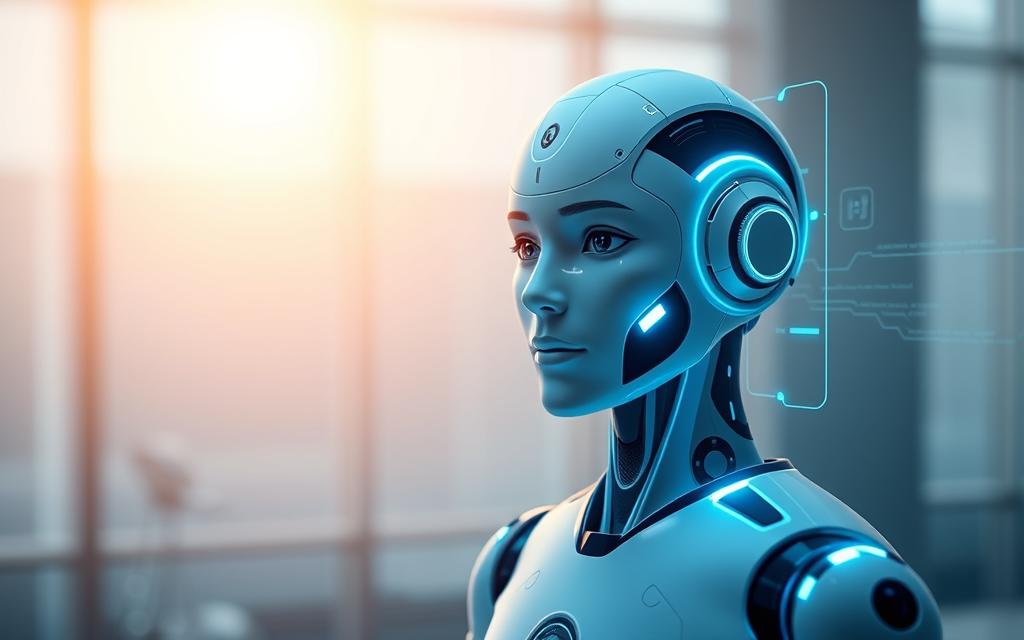Modern digital solutions increasingly rely on advanced systems to handle customer interactions. The rise of tools like ChatGPT and Gemini has sparked debates about what truly constitutes artificial intelligence in conversational platforms. This guide examines the technical boundaries between different approaches to automated communication.
Early automated response systems followed strict, pre-programmed rules. Today’s sophisticated programmes can craft original responses and adapt to complex scenarios. These advancements raise important questions about categorisation and practical applications for organisations.
Understanding these distinctions helps businesses choose appropriate solutions. Rule-based systems excel in predictable scenarios, while generative counterparts offer flexibility for dynamic interactions. Decision-makers must weigh factors like cost, accuracy, and adaptability when implementing these technologies.
This analysis explores real-world implementations across industries. We’ll compare traditional frameworks with newer models that learn from vast datasets. The discussion provides crucial insights for optimising digital strategies in our increasingly automated world.
Introduction to AI in Customer Engagement
Organisations across the UK are redefining how they connect with audiences through intelligent systems. Over half of British consumers now expect instant resolutions to queries, with 58% preferring digital communication over traditional channels. This shift has pushed customer service teams to adopt tools that combine speed with contextual understanding.
Nearly 80% of business leaders report updating engagement strategies to leverage conversational technologies.
“The ability to analyse language patterns and deliver tailored responses has become essential,”
notes a recent industry report. Retailers and financial institutions lead this transformation, using advanced systems to handle everything from product inquiries to complex account management.
Key benefits driving adoption include:
- 24/7 availability without staffing constraints
- Consistent quality across thousands of daily interactions
- Data-driven insights into consumer behaviour patterns
Healthcare providers and telecom operators demonstrate how these systems scale specialised support. A hospital network recently reduced appointment booking errors by 40% using intelligent response tools, while a mobile operator cut call centre volumes by 35%.
Early adopters gain measurable advantages in satisfaction metrics and operational costs. However, successful implementation requires aligning technological capabilities with specific customer needs. The most effective solutions balance automated efficiency with human oversight for complex scenarios.
Understanding Artificial Intelligence: Core Concepts
Technological advancements continue reshaping how industries operate, with intelligent systems driving unprecedented efficiencies. At the heart of this transformation lies artificial intelligence, a field combining mathematical principles and computational power to replicate human-like reasoning.
Defining AI and Its Components
Artificial intelligence systems rely on interconnected technologies to process information. Machine learning algorithms form the backbone, enabling pattern recognition from historical data. These models work alongside neural networks and natural language processing tools to analyse inputs and deliver context-aware outputs.
Modern frameworks excel at tasks ranging from image classification to predictive analytics. Their effectiveness depends on two critical elements: the quality of training data and the sophistication of algorithmic models. Together, these components allow systems to improve iteratively without explicit reprogramming.
Historical Overview and Evolution
The journey began with Andrey Markov’s 1906 research on stochastic processes, laying groundwork for probabilistic models. Early symbolic systems dominated until the 1980s, when neural network architectures gained traction. Breakthroughs in computing power later enabled deep learning techniques that power today’s most advanced solutions.
Contemporary applications demonstrate remarkable adaptability, learning from new information in real time. This evolutionary path highlights how theoretical concepts from mathematics have matured into practical tools transforming global industries.
Unpacking Conversational AI
Advanced dialogue systems now handle nuanced exchanges that once required human intervention. These platforms combine natural language processing with adaptive learning to interpret intent, manage context, and deliver coherent responses. Their ability to mimic human-like interactions makes them invaluable for businesses scaling operations.
Features and Capabilities
Modern systems analyse human language using layered algorithms. Key functionalities include:
- Context retention across multi-turn conversations
- Real-time sentiment analysis for tailored replies
- Integration with backend databases for factual accuracy
These tools learn from historical interactions, refining their language processing capabilities through continuous feedback loops. A 2023 study found enterprises using such systems reduced resolution times by 52% compared to traditional methods.
| Industry | Application | Technology |
|---|---|---|
| Retail | Personalised shopping assistants | Intercom’s AI-driven chat |
| Healthcare | Appointment scheduling | Nuance voice recognition |
| Telecoms | Fault diagnostics | Amelia’s problem-solving algorithms |
Real-World Industry Examples
Google Assistant handles over 1 billion monthly queries in the UK alone, demonstrating the scalability of voice-activated solutions. Financial institutions deploy these systems for fraud detection, analysing patterns in users’ transaction histories.
“The integration of machine learning with linguistic models has revolutionised how we approach customer engagement,”
states a Barclays innovation report. Meanwhile, platforms like Replika showcase the personalisation potential, adapting conversational styles to individual preferences.
For organisations evaluating AI solutions, understanding these distinctions ensures optimal implementation strategies. The sector’s projected £13 billion valuation by 2027 underscores its transformative impact.
Unleashing Generative AI for Innovation
Creative industries are undergoing radical transformation through advanced computational tools. These systems analyse patterns in existing materials to produce original works spanning visual art, written text, and multimedia formats. Organisations now leverage this capability to streamline production processes while maintaining artistic integrity.
Techniques for Content Generation
Modern systems employ neural networks trained on millions of images and documents. Generative adversarial networks (GANs) refine outputs through iterative feedback loops, creating photorealistic visuals from simple prompts. Transformer architectures power text generation, producing coherent articles that match specific tones and styles.
Platforms like DALL-E demonstrate how textual descriptions translate into detailed visuals. A fashion brand recently used similar technology to prototype 500 design concepts in 48 hours – a task previously requiring six months.
Applications in Creative Industries
Advertising agencies utilise these tools for rapid campaign ideation. Training data from past successful campaigns informs new creatives that resonate with target demographics. Publishers automate first drafts of seasonal content, allowing writers to focus on nuanced editing.
“Our editorial output increased 300% without compromising quality,”
reports a London-based media house. Film studios now generate storyboard concepts in hours rather than weeks, accelerating pre-production timelines. The technology’s £10 trillion potential stems from its ability to scale content creation while preserving human creative direction.
The Evolution of AI: From Chatbots to Deep Learning
The transformation of automated response systems reflects decades of computational breakthroughs. Early tools relied on rigid decision trees, struggling with unpredictable queries. Their keyword-matching algorithms couldn’t grasp context or intent, limiting real-world usefulness.
Everything changed in 2014 with two revolutionary training approaches. Variational autoencoders and generative adversarial networks enabled machines to learn complex patterns independently. These models could suddenly generate original images and text rather than regurgitating pre-set answers.
The 2017 Transformer architecture supercharged this progress. Its self-attention mechanism allowed systems to analyse relationships between words across entire documents. This breakthrough laid foundations for GPT-1 and GPT-2, which demonstrated unprecedented language mastery.
| Year | Development | Impact |
|---|---|---|
| 2014 | VAE & GAN innovations | Enabled generative content creation |
| 2017 | Transformer networks | Revolutionised contextual analysis |
| 2018-2019 | GPT series launch | Advanced multi-task generalisation |
This evolution shifted focus from discriminative to generative approaches. Modern systems now create marketing copy, design prototypes, and solve novel problems. A 2023 Cambridge study found deep learning architectures outperform humans in 74% of creative brainstorming tasks.
Organisations benefit from tools that learn continuously from interactions. The technology’s £4.3 billion UK market valuation stems from its ability to adapt across industries. As learning capabilities expand, so do opportunities for innovation.
Is chatbot generative ai? Debunking the Myths
A common misunderstanding in tech circles conflates automated response tools with creative content generators. While both use algorithms to process information, their operational blueprints differ fundamentally. Traditional systems rely on predefined rules and curated data sets rather than spontaneous creation.
Rule-based solutions excel at matching user queries with stored outputs through pattern recognition. These models analyse language structures to select appropriate replies from existing databases. A banking helpline tool, for instance, might reference 15,000 pre-approved responses rather than inventing new ones.
Generative counterparts employ neural networks that produce original text or images. These systems synthesise information from vast data pools to craft unique answers. As a Microsoft study notes:
“Retrieval-based tools achieve 92% accuracy in scripted scenarios, while generative versions handle unpredictable queries better.”
Key distinctions emerge in their models:
- Discriminative architectures classify inputs into existing categories
- Generative frameworks create fresh content through probabilistic calculations
Most customer service platforms blend both approaches strategically. A travel booking tool might use fixed responses for flight queries but generate personalised hotel suggestions. This hybrid approach balances reliability with adaptability.
Understanding these mechanics helps organisations allocate resources effectively. Solutions requiring strict compliance benefit from rule-based models, while marketing teams might prioritise generative capabilities. The choice ultimately hinges on whether interactions demand consistency or creativity.
Distinctions Between Chatbots, Conversational AI, and Generative AI
Digital communication tools vary widely in their complexity and application. Rule-based systems answer common queries through pre-written scripts, while more advanced platforms handle dynamic exchanges. Understanding these differences helps businesses select solutions aligned with operational needs.
Three core technologies dominate automated engagement:
| Technology | Core Function | User Interaction |
|---|---|---|
| Basic Chatbots | Deliver scripted responses using decision trees | Single-turn exchanges |
| Conversational Platforms | Analyse context across dialogue threads | Multi-session discussions |
| Generative Systems | Produce original text/media outputs | Content creation requests |
Basic automated tools operate within strict parameters, ideal for repetitive tasks like balance checks. Artificial intelligence solutions with natural language processing handle nuanced discussions about account management. As a Vodafone case study revealed:
“Our hybrid system resolves 68% of billing enquiries without human intervention.”
Advanced platforms remember preferences across interactions, personalising future exchanges. Creative generators work differently, synthesising data to produce marketing copy or design concepts. Users typically engage these systems through specific prompts rather than conversations.
Implementation strategies depend on desired outcomes. Compliance-driven sectors favour predictable tools, while customer-facing teams prioritise adaptive capabilities. Successful enterprises often combine multiple approaches for comprehensive coverage.
Integrating AI into Chatbot Technology
Digital communication platforms now blend time-tested methods with next-generation capabilities. This fusion creates responsive tools that adapt to diverse user needs while maintaining operational stability. By weaving together different technological approaches, developers achieve balanced solutions for modern enterprises.
Bridging Conventional and Modern Systems
Hybrid chatbot architectures leverage rule-based reliability for common queries. When interactions grow complex, machine learning modules activate to analyse context and intent. Banks like HSBC use such systems to handle 73% of routine enquiries while escalating nuanced cases.
Strategic integration optimises resource allocation. Basic tasks utilise lightweight algorithms, preserving computational power for sophisticated intelligence processing. Retailers report 60% faster response times using this layered approach compared to single-model systems.
Key benefits include:
- Consistent accuracy for standard requests
- Adaptive problem-solving for unique scenarios
- Scalable infrastructure costs
These tools evolve through continuous feedback, refining their decision-making protocols. As machine capabilities advance, hybrid models will likely dominate sectors requiring both precision and creativity in customer interactions.

















